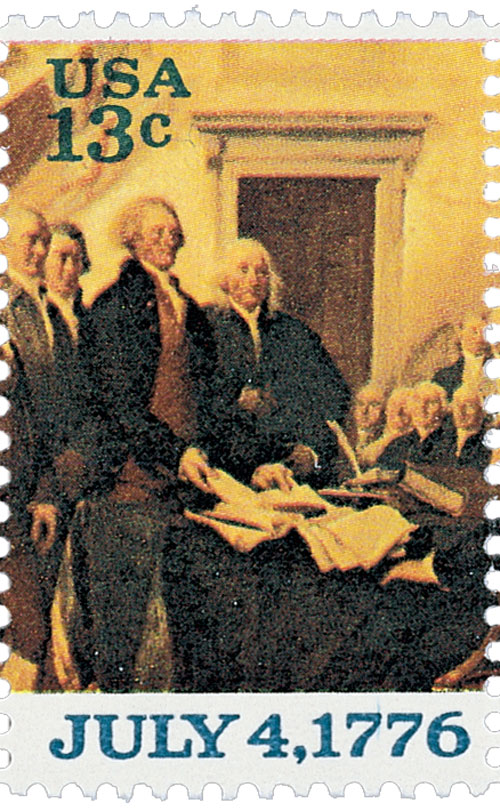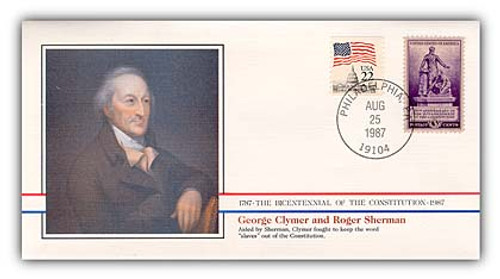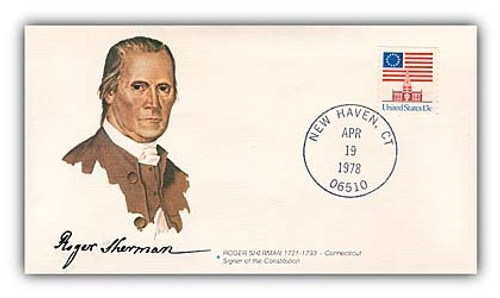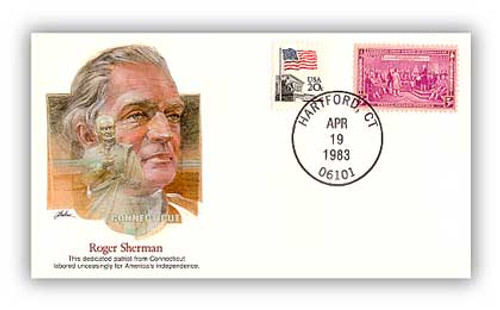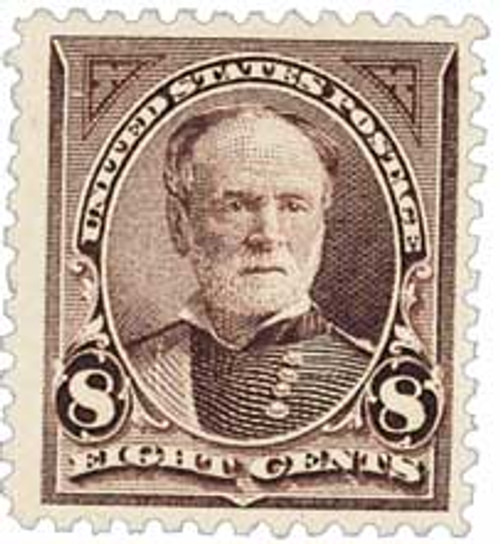
# 97429 - 1987 Sherman Proposes Gold & Silver as Tender
 Constitution Bicentennial Cover Honors Roger Sherman, Opponent of Paper Currency
Own this cover marking the bicentennial of the US Constitution, the document that framed America’s government. It commemorates the August 28, 1787, speech by Connecticut delegate Roger Sherman. He wanted the Constitution to prohibit the issuance of paper money, while approving gold and silver currency. At the time, each state was issuing its own currency, and paper money had led to significant inflation.
The Hartford, Connecticut, postmark on the cover pays tribute to the captital city of Connecticut. The cover features a California Gold Rush Centennial stamp (#954) and a Flag Over the Capitol stamp.
This cover is part of a series issued in honor of the Bicentennial of the Constitution. Begin your mini-collection of these covers today.
Death Of Roger Sherman
Â
Â
Â
Â
Â
Â
Roger Sherman, the only man in US history to sign America’s four most important documents; the Articles of Association, the Declaration of Independence, the Articles of Confederation, and the Constitution, died on July 23, 1793.
Sherman was born on April 19, 1721, in Newton, Massachusetts. With few educational opportunities available to him, Sherman read every spare minute – and often had a book open at his workbench in his father’s shoe repair shop.
After his father died, he moved to New Milford, Connecticut and with his brother, opened the town’s first store. Sherman first held an official office in 1745 when he was made surveyor of New Haven County. He was also made the town clerk of New Milford and produced a popular Almanac there each year from 1750 to 1761.
Sherman was accepted to the Bar in 1754 and elected to the General Assembly the following year. He went on to serve as a justice of the peace and justice of the Superior Court of Connecticut. By the time he was 40, Sherman established himself as a prominent lawyer and politician.Â
Â
Â
Â
Â
Â
Â
When the Revolutionary War broke out, Sherman was made commissary to the Connecticut Troops. He was then elected to the Continental Congress in 1774. Sherman helped create the Articles of Association, a precursor to the Declaration of Independence which established a trade boycott with Great Britain. Well-respected among his peers for his honesty and integrity, Sherman was also selected to help create the Declaration of Independence and the Articles of Confederation.
Â
Â
Â
Â
Â
Â
At the Constitutional Convention, Sherman was noted for his impassioned support of a strong federal government and the rights of smaller states. With 138 speeches to the convention, Sherman was by far one its most vocal members. Fisher Ames once said that in cases of uncertainty he looked at Roger Sherman, knowing that “if I vote with him I shall vote right.â€
Â
Â
Â
Â
Â
Â
Among Sherman’s notable contributions was the inclusion “or to the people†in the 10th Amendment to the Constitution and the use of the cent in America’s financial system. Sherman died in his sleep on July 23, 1793.
Â
 Constitution Bicentennial Cover Honors Roger Sherman, Opponent of Paper Currency
Own this cover marking the bicentennial of the US Constitution, the document that framed America’s government. It commemorates the August 28, 1787, speech by Connecticut delegate Roger Sherman. He wanted the Constitution to prohibit the issuance of paper money, while approving gold and silver currency. At the time, each state was issuing its own currency, and paper money had led to significant inflation.
The Hartford, Connecticut, postmark on the cover pays tribute to the captital city of Connecticut. The cover features a California Gold Rush Centennial stamp (#954) and a Flag Over the Capitol stamp.
This cover is part of a series issued in honor of the Bicentennial of the Constitution. Begin your mini-collection of these covers today.
Death Of Roger Sherman
Â
Â
Â
Â
Â
Â
Roger Sherman, the only man in US history to sign America’s four most important documents; the Articles of Association, the Declaration of Independence, the Articles of Confederation, and the Constitution, died on July 23, 1793.
Sherman was born on April 19, 1721, in Newton, Massachusetts. With few educational opportunities available to him, Sherman read every spare minute – and often had a book open at his workbench in his father’s shoe repair shop.
After his father died, he moved to New Milford, Connecticut and with his brother, opened the town’s first store. Sherman first held an official office in 1745 when he was made surveyor of New Haven County. He was also made the town clerk of New Milford and produced a popular Almanac there each year from 1750 to 1761.
Sherman was accepted to the Bar in 1754 and elected to the General Assembly the following year. He went on to serve as a justice of the peace and justice of the Superior Court of Connecticut. By the time he was 40, Sherman established himself as a prominent lawyer and politician.Â
Â
Â
Â
Â
Â
Â
When the Revolutionary War broke out, Sherman was made commissary to the Connecticut Troops. He was then elected to the Continental Congress in 1774. Sherman helped create the Articles of Association, a precursor to the Declaration of Independence which established a trade boycott with Great Britain. Well-respected among his peers for his honesty and integrity, Sherman was also selected to help create the Declaration of Independence and the Articles of Confederation.
Â
Â
Â
Â
Â
Â
At the Constitutional Convention, Sherman was noted for his impassioned support of a strong federal government and the rights of smaller states. With 138 speeches to the convention, Sherman was by far one its most vocal members. Fisher Ames once said that in cases of uncertainty he looked at Roger Sherman, knowing that “if I vote with him I shall vote right.â€
Â
Â
Â
Â
Â
Â
Among Sherman’s notable contributions was the inclusion “or to the people†in the 10th Amendment to the Constitution and the use of the cent in America’s financial system. Sherman died in his sleep on July 23, 1793.
Â




